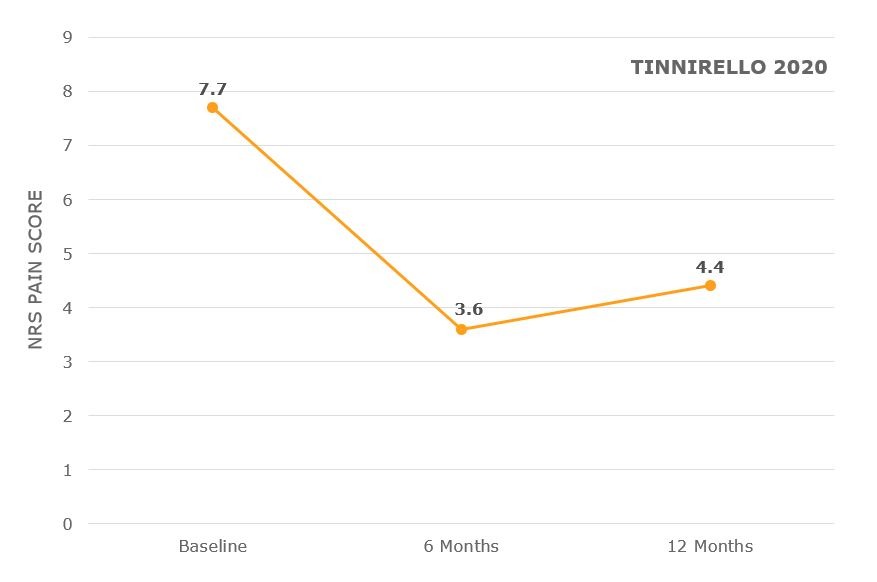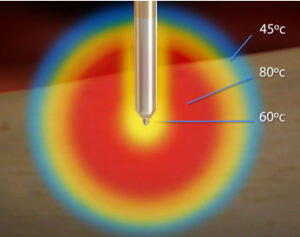The sacroiliac joint (SIJ) is located where the sacrum and iliac bones meet to form the pelvic girdle, which supports the weight of the entire upper body and protects vital organs. The SIJ is not designed for excessive movement, and when subjected to stress, the cartilage in the SIJ can deteriorate, resulting in painful bone-on-bone rubbing.1,2 SIJ pain has been attributed to many causes, including infection, inflammatory diseases, malignancy, pregnancy, lumbar spinal fusion, torsional strain, trauma, aging and wear-and-tear.2–5
Limitations of Conventional Management Options
- Limited duration of action and significant associated risks6
- Physical therapy is contingent on patient mobility and compliance
 Advantages of Using COOLIEF* Cooled Radiofrequency
Advantages of Using COOLIEF* Cooled Radiofrequency
COOLIEF* Cooled RF can bridge the gap between short-term pain relief treatments and surgery by providing a minimally invasive, non-opioid procedure for SIJ-derived pain.
Specifically designed to treat complex anatomy of variable nerve courses, COOLIEF* Cooled RF uses water-cooled technology that enables more RF energy to safely deactivate pain-transmitting sensory nerves. This creates a larger, spherical lesion that distally projects 45% or greater beyond the probe’s tip, allowing physicians to approach the target nerve from any angle.
- Demonstrates up to 24 months pain relief with improved physical function and a reduction in opioid medication usage
- Delivers up to 3.7x more energy than standard RF
- In a randomized, placebo-controlled study, at 3-months post-procedure, 64% of patients obtained pain relief of 50% or greater and saw clinically relevant functional improvement7
Examining Impact of CRFA on Opioid Intake6
A 2020 one-year retrospective study published in The Korean Journal of Pain evaluated the impact of CRFA on opioid usage for subjects with chronic SIJ pain. Researchers analyzed the records of 27 subjects who received CRFA for SIJ pain. Subjects were evaluated for pain, function, opioid intake and safety at one, six and 12 months using the NRS, ODI and Morphine Equivalent Daily Dose (MEDD). The primary outcome measure was the reduction of opioid consumption after CRFA as measured by MEDD.
6-MONTH RESULTS
NRS Pain Scores for 6-Month Time Point

Pain
Subjects who received CRFA reported a mean NRS decrease of 4.1 points.
Function
Subjects who received CRFA reported a mean decrease of 24.6 points in ODI score.
Opioid Reduction
Subjects who received CRFA experienced a mean reduction of 25mg MEDD.
At 6 months, the CRFA group demonstrated 27.8% fewer patients taking opioids than at baseline. There was a mean reduction of 25mg MEDD.
Key Takeaway: CRFA significantly improves SIJ pain, function and quality of life while decreasing the chronic usage of opioids to manage pain through 6 months.
12-MONTH RESULTS
NRS Pain Scores for 12-Month Time Point

Pain
Subjects who received CRFA reported a mean NRS decrease of 3.2 points.
Function
Subjects who received CRFA reported a mean decrease of 20.2 points in ODI score.
Opioid Reduction
Subjects who received CRFA demonstrated a mean reduction of 15mg MEDD.
At 12 months, the CRFA group showed 13% fewer patients chronically taking opioids than at baseline. There was a mean reduction of 15mg MEDD.
Key Takeaway: CRFA is effective in reducing both pain and opioid usage in subjects with chronic SIJ pain through 12 months.

Click here for Instructions for Use
References:
- Ramasubba C, Cohen SP. Cooled sacroiliac radiofrequency denervation for the treatment of pain secondary to tumor infiltration: a case-based focused literature review. Pain Physician. 2013;16(1):1-8.
- Karaman H, Kavak GÖ, Tüfek A, et al. Cooled radiofrequency application for treatment of sacroiliac joint pain. Acta Neurochir. 2011;153(7):1461-1468.
- Chou LH, Slipman CW, Bhagia SM, et al. Inciting events initiating injection-proven sacroiliac joint syndrome. Pain Med. 2004;5(1):26-32.
- Cohen SP. Sacroiliac joint pain: a comprehensive review of anatomy, diagnosis, and treatment. Anesth Analg. 2005;101(5):1440-1453.
- Fortin JD. Sacroiliac joint dysfunction a new perspective. J Back Musculoskelet Rehabil. 1993;3(3):31-43.
- Tinnirello A. Reduction of opioid intake after cooled radiofrequency denervation for sacroiliac joint pain: a retrospective evaluation up to 1 year. Korean J Pain. 2020;33(2):183-191.
- Patel N, Gross A, Brown L, Gekht G. Pain Medicine, “A Randomized, Placebo-Controlled Study to Assess the Efficacy of Lateral Branch Neurotomy for Chronic Sacroiliac Joint Pain”. 2012;13:383-398.

 Advantages of Using COOLIEF* Cooled Radiofrequency
Advantages of Using COOLIEF* Cooled Radiofrequency